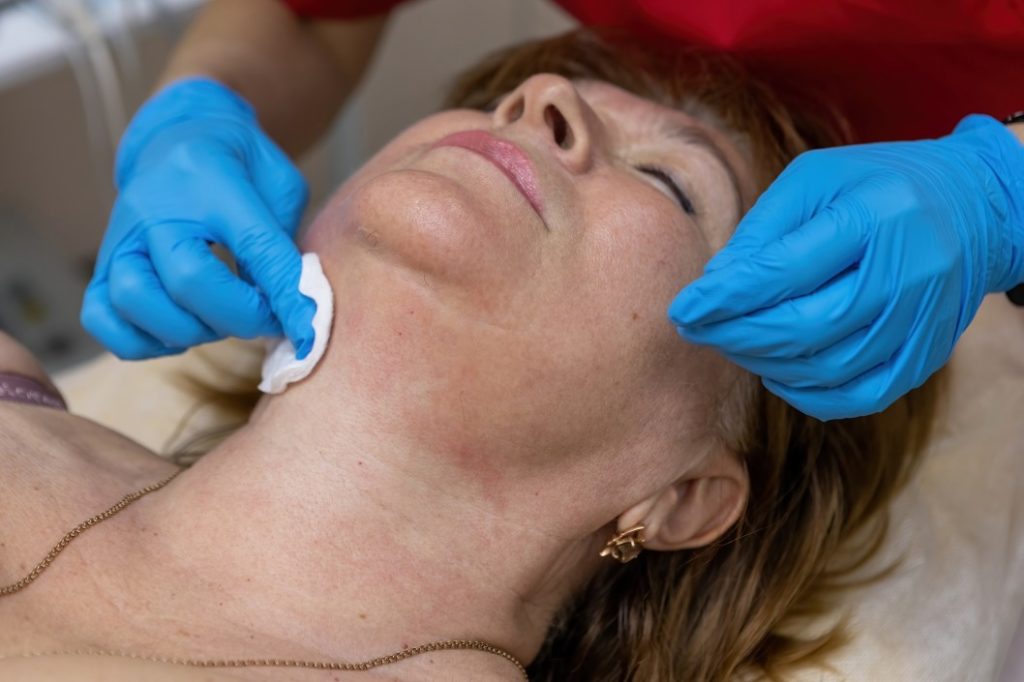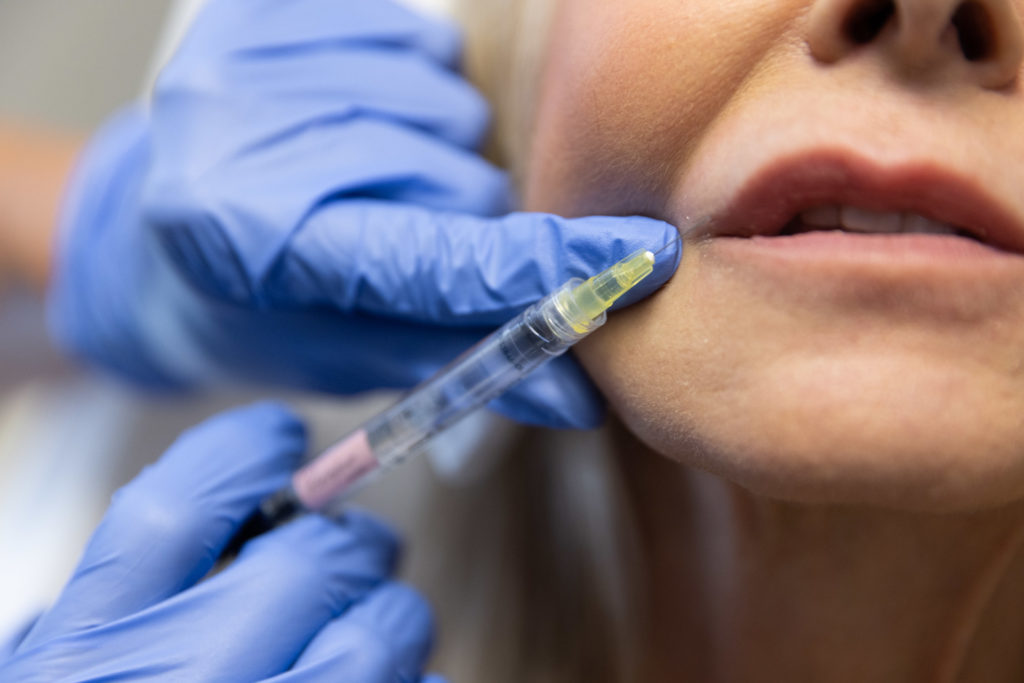When you think about facial fillers in Dallas, you might automatically think of lip injections. The full, pouty lips have been all the talk the last few years. Or, maybe you think of Botox decreasing the appearance of wrinkles. And although your associations aren’t necessarily wrong, there are some key differences between facial fillers and other types of injectables.
At Southlake Plastic Surgery, we value educating our patients on all of their different options. Each patient is a unique individual who has their own goals and we will always honor that.
As long as you’re open with us about your aesthetic goals, we will provide you with information about treatment options we know will best meet those goals. Your only job is taking your new understanding of the different treatments and choosing which path you want to take.
What are facial fillers?
Facial fillers, also referred to as dermal fillers, are gel solutions made of hyaluronic acid and lidocaine and are meant to volumize the face by filling in hollow spaces and smoothing wrinkles. Hyaluronic acid is found naturally in your body, while lidocaine is a substance that helps reduce pain and swelling, making recovery time minimal to none. Plus, there is no waiting game–the results are immediate!
Which areas can they treat?
Dermal fillers can:
- Smooth mild-to-moderate facial lines
- Plump up lips
- Volumize and contour cheeks by lifting sagging skin
- Improve chin and jawline structure
- Rejuvenate hands by correcting lost volume
- Restore volume in under-eye bags
How long do they last?
Generally speaking, fillers can last anywhere between 6-12 months. Some types can even last for as long as 18 months or more. Since hyaluronic acid is found naturally in us, our bodies know how to break it down. Many of our patients keep returning for more fillers to maintain these results.
Methods of injecting: Needle and Cannula
Now that we’ve covered our available facial fillers in Dallas, let’s get into a little more of the nitty gritty: The different methods of injecting.
Needle
Traditionally, fillers have been injected with a hypodermic needle, which pierces through the skin into the subcutaneous tissue (tissue under the skin). Because filler needs to be injected into multiple parts of your face, the needle will have to penetrate the skin multiple times.
Cannula
A more “recently” discovered way of injecting fillers is through cannulas. A cannula is an extremely thin tube with a round, blunt tip. Cannulas can be inserted into veins or body cavities to administer medicine, or in this case, dermal fillers.
Cannulas do not pierce through the skin in the same way needles do because of the blunt tip, so our expert injectors have to initially pierce the skin with a needle in order to insert the cannula. The cannula can then maneuver through different areas of the skin and inject the filler without having to pierce multiple areas.
How do I know which method is right for me?
Both methods of injecting fillers are widely-accepted and used by aesthetic specialists. The cannula method is good for certain areas on the face or neck that contain a lot of nerves and blood vessels. The single injection point reduces the chances of puncturing these nerves and blood vessels, which is what causes bruising and swelling.
Patients who bruise easily can benefit from the cannula method. If bruising isn’t a concern for you and you just want to try a more advanced technique, then opt for the cannula method!
Our providers at Southlake will be happy to talk you through the options and address any questions or concerns you have. To learn more about the two different methods of injecting filler, read our Cannula vs Needle blog.
Other types of injectables
Like facial fillers in Dallas, other types of injectables also seek to restore lost volume and facial structure. The key difference is that facial fillers are made of hyaluronic acid, while other injectables are composed of different materials. Lindsey Van Meter tells us the difference between Botox, fillers, and Sculptra in this video!
Sculptra
Sculptra is an example of an injectable that shares the same goal as facial fillers (restoring facial structure and volume), but the path to meeting that goal looks quite different. It is made of poly-L-lactic acid and is a collagen stimulator. Collagen is a protein found in skin that makes it appear healthy and smooth.
Sculptra still fills the hollow spaces once injected, but this effect does not behave in the same way fillers do. You may be wondering, “What’s the point then?” Well, even though you won’t be able to see the results right away, Sculptra is ordering your body to produce more collagen which will lead to fuller, healthier skin over time.
Which areas can Sculptra treat?
Similar to fillers, Sculptra can treat lost facial volume, including in the chin and jawline, as well as restore volume in the hands. It can also act as an alternative to buttocks implants by adding volume.
Unlike fillers, Sculptra can’t be injected into the lips. It may be able to plump up your peach, but if you’re looking to plump your lips, facial fillers would be the treatment for you.
How long does Sculptra last?
The injections are completed in a series of 2-3 treatments spaced approximately 4-6 weeks apart. The number of treatments depends on the amount of volume lost. Most patients need 1 vial of Sculptra per decade of life. Once your first round of Sculptra is complete, it can last up to 2 years. After those 2 years, maintenance treatments are needed once per year.
Is recovery time the same as for facial fillers?
While recovery time with facial fillers is minimal to none, Sculptra may cause soreness and bruising at the injection site for up to 7 days afterwards.
Considering Sculptra?
Learn more about it in our Everything You Need to Know About Sculptra in Dallas blog. Not sure whether dermal fillers or Sculptra would be more suitable for you? Check out our Sculptra vs. Fillers blog!
Botox and Dysport
Here’s where things get interesting. Oftentimes people use Botox and fillers interchangeably, though they are entirely different. Facial fillers and Botox are both injectables, but Botox is a neuromodulator, which decreases the ability for your facial muscles to contract, in turn decreasing wrinkles and fine line formation.
Dysport is also a neuromodulator and performs similarly to Botox. Botox and Dysport are not filling in hollow spaces and wrinkles, they are stopping muscles from forming those wrinkles in the first place.
In general, for younger adults, Botox and Dysport are more preventative while facial fillers and Sculptra are more corrective. Neuromodulators will still reduce the appearance of wrinkles, but also prevent more from forming.
Which areas can Botox and Dysport treat?
The glabella (the space between your eyes), forehead lines, crow’s feet (smile lines beside your eyes), and several other areas.
How long do Botox and Dysport last?
While facial fillers in Dallas last between 6 and 12 months, results from Botox and Dysport will generally last around 3-4 months. For both neuromodulators, the results will take up to 5-10 days to fully take effect.
What about recovery time?
Like dermal fillers, recovery time is minimal. Initially you will see small areas of redness or bumps, but these subside quickly. It is important not to rub or massage the injected areas on the day of treatment. You will also need to refrain from lying flat for 4 hours after the treatment.
Botox or Dysport?
Though there are minute differences between Botox and Dysport, we want you to be happy with your treatment plan and results. You can learn about those differences in our Dysport vs. Botox blog.

Kybella
Kybella is an injectable with the goal of getting rid of pockets of fat, such as the “double chin”, also known as submental fat. It can also be used for small areas of fat on other parts of the body, such as “bra fat”. Kybella contains deoxycholic acid, a bile acid that destroys fat cells.
What is the treatment process?
Most patients have at least two treatments spaced 4 to 6 weeks apart. If you have stubborn fat under your chin, Kybella may be the treatment for you to attain your dream profile.
By scheduling a visit with us, we can help you decide whether Kybella, facial fillers, or Sculptra is the solution for you.
How long does Kybella last?
Since Kybella destroys fat cells, those in the treated area will not return.
What is the recovery process?
Though there is no downtime after a Kybella injection, there will be swelling, bruising, pain, and redness for 4-6 weeks. Immediately after treatment, you will see significant swelling that will subside over the next few days. Most patients see full results after 6-8 weeks.
Lions and tigers and fillers, oh my!
As you can see, we offer many options for getting you to the best version possible. You deserve to feel happy when you look in the mirror or when you see that tagged photo your best friend posted.
Maybe you feel excited with this newfound knowledge of all of the treatment options that are available to you. If that’s the case, we are so happy!
Maybe, though, you’re feeling a little overwhelmed with all of the types of fillers and injectables.
Luckily, the providers at Southlake Plastic Surgery are experts in the field when it comes to all things injectables! We take pride in being an active resource to help you figure out your aesthetic goals. That’s why we’ve built a guide to the specific types of dermal fillers we offer.
Still unsure?
If you’re still unsure about what your next steps look like, that’s okay too. Fill out this form and we will happily answer any questions you have.
Ready to book an appointment?
Are you ready to be the most confident version of yourself? Schedule your appointment with us today. Our specialists are waiting to build a unique treatment plan just for you!


